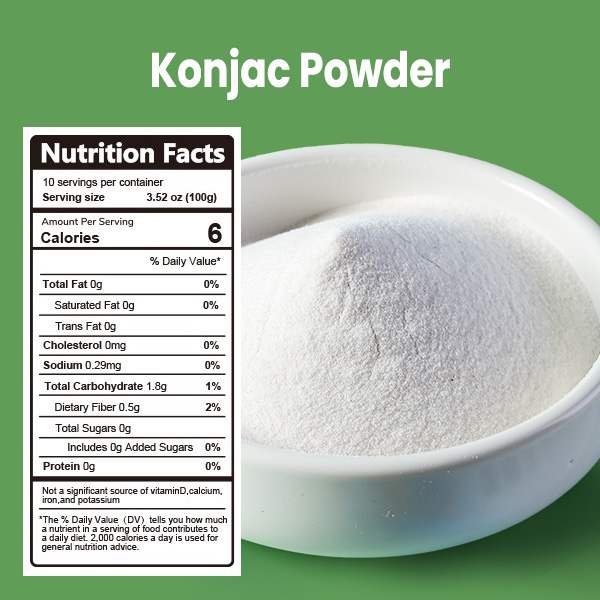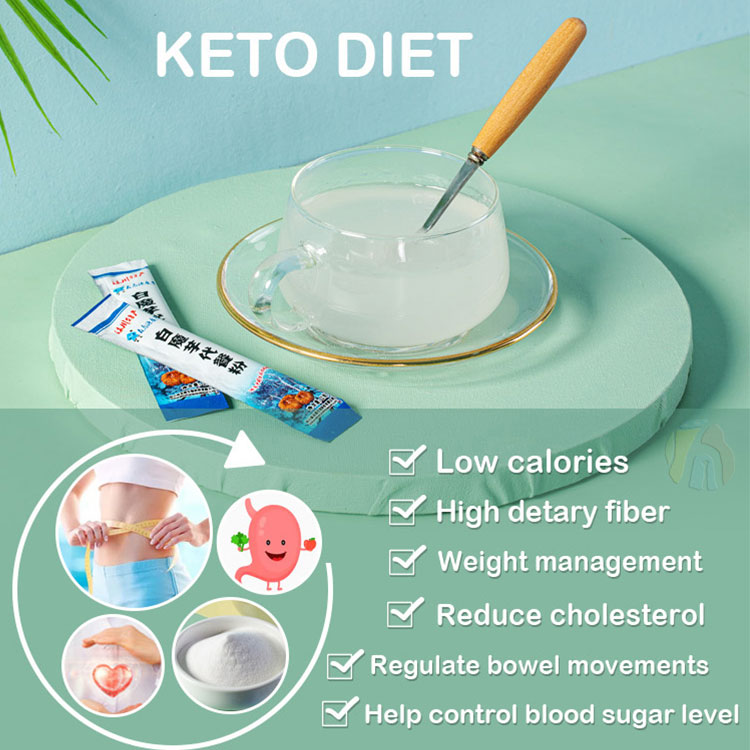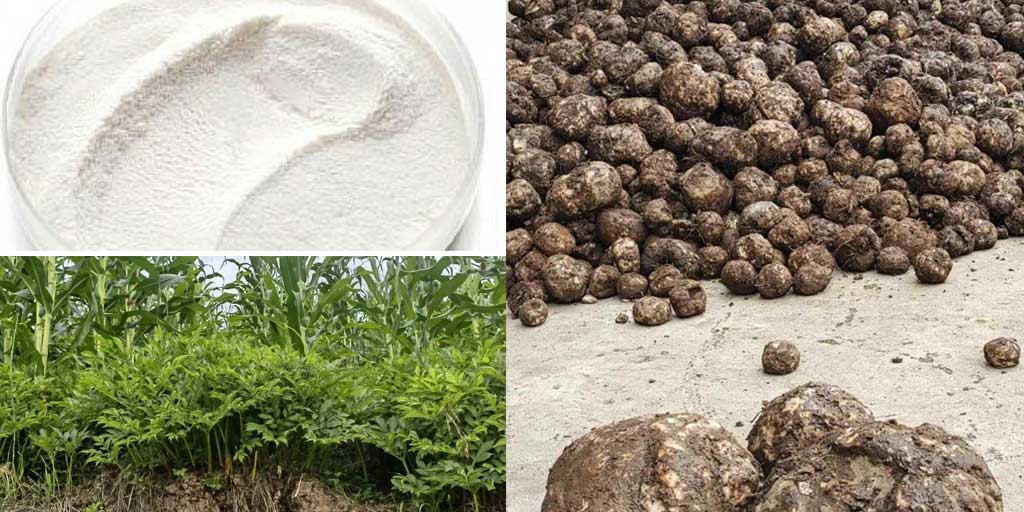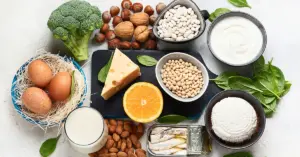Amorphophallus, commonly known as konjac or devil’s tongue, is a perennial herbaceous plant belonging to the Araceae family. It has broad, palm-shaped leaves that resemble a large diamond. Well-developed erect petioles can reach a height of 2 meters, and the underground corm is spherical.
Konjac is mainly distributed in tropical rainforests and subtropical monsoon regions. Its main component is glucomannan, which is rich in essential amino acids and trace elements needed by the human body.
It is characterized by high-quality dietary fiber and low-fat acids. It can effectively relieve constipation, prevent obesity, reduce blood lipids, blood sugar, and cholesterol, regulate endocrine function, and has remarkable effects in cancer prevention, promoting bowel movements, increasing appetite, and boosting metabolism.
Medical research has shown that konjac has preventive and therapeutic effects on modern diseases such as hyperlipidemia, diabetes, obesity, and tumors, as well as cardiovascular and cerebrovascular diseases.
Konjac contains 40% to 65% glucomannan, followed by 3% to 4% ash content and 12% to 15% impurities such as starch. It also contains beneficial substances for the human body, such as pectin, alkaloids, 17 types of amino acids, and trace elements.

Firstly, glucomannan is the most abundant sugar in Konjac. It has a strong water-absorbing capacity and is more viscous than any other plant gum. It can fill the stomach, and eliminate hunger pangs, and due to its low-calorie content, it can help control weight and achieve weight loss and fitness goals.
Secondly, konjac has the effect of reducing blood lipids. In a nutritionist study, mice were divided into two groups and fed equal amounts of high-fat food. One group was not given konjac, while the other group was given a small amount of konjac powder. The results showed that the mice in the konjac-fed group had cholesterol levels over 100 milligrams lower than the other group.
Thirdly, konjac has a gelation effect. By extracting and separating mature konjac and processing it into konjac powder, a konjac gel can be made by adding water and heating. When this gel is consumed, it forms a semi-transparent film coating on the intestinal wall, which prevents the absorption of various harmful substances, especially carcinogens. Therefore, the konjac is also known as the “anti-cancer magical garment.“
Fourthly, konjac can increase the secretion of enzymes in the small intestine, accelerate the clearance of intestinal deposits, and promote their timely elimination from the body. Thus, konjac not only stimulates appetite and aids digestion but also helps in clearing intestinal waste.
Fifthly, konjac has a film-forming effect. When konjac powder is used as a primary ingredient combined with other ingredients in food production, it can form a protective antibacterial film on the food surface, preventing bacterial invasion and extending the shelf life by preserving freshness.

Due to its strong water-absorbing ability, high viscosity, and high expansion rate, konjac glucomannan can expand 20-100 times its size after entering the stomach and absorbing gastric juice, creating a feeling of fullness.
Therefore, konjac is also considered a weight-loss food. Consuming konjac can prevent intestinal diseases caused by insufficient fiber intake. Konjac glucomannan also has the effect of lowering blood pressure and blood sugar, as well as preventing diabetes, gallstones, arteriosclerosis, cardiovascular diseases, and certain types of cancer.
Consuming konjac food can lower patients’ cholesterol and triglycerides, increase their high-density lipoprotein, decrease their low-density lipoprotein, and significantly increase their apolipoprotein AI. Research has shown that konjac glucomannan has a certain therapeutic effect in preventing and treating cardiovascular diseases caused by hyperlipidemia.
It improves glucose tolerance and prevents diabetes.
Studies by Japanese experts have shown that after taking konjac glucomannan, the retention time of food in the stomach is prolonged, the digestion process slows down, and diabetes patients with insufficient insulin secretion can maintain balance at lower levels, thereby controlling blood sugar.
It treats constipation and prevents lower digestive tract diseases.
Almost all clinical trials have shown that konjac glucomannan fiber effectively relieves constipation. The viscosity and lubricating effect of konjac glucomannan can shorten the transit time of food in the intestines.
Through fermentation by intestinal bacteria, it produces short-chain fatty acids, stimulates intestinal peristalsis, increases stool moisture, softens the stool, increases its volume, and facilitates bowel movements. Studies have shown that 90% of constipation cases were relieved when individuals consumed 8.6 grams of konjac products daily.

Weight Loss Effect
After being absorbed and expanded, konjac glucomannan increases the volume of food paste, providing a sense of fullness that helps reduce food intake. At the same time, glucomannan does not generate calories and can reduce the absorption of calorie-producing foods such as sugars and fats. Therefore, consuming a certain amount of glucomannan daily can prevent obesity and aid in gradual weight loss.
Glucomannan possesses immune-regulating activity and can activate various immune cells, promoting the secretion of cytokines.
The health benefits of konjac mainly manifest in weight loss, lowering blood lipids, reducing blood sugar, alleviating constipation, and inhibiting the occurrence of colorectal cancer.
The health benefits of konjac glucomannan (KGM) are related to its molecular weight. The higher the molecular weight, the greater the viscosity, and the more significant the health effects.
From a nutritional perspective, konjac glucomannan (KGM) is an excellent dietary fiber. It has a high expansion coefficient, promotes gastrointestinal motility, increases satiety, and reduces the absorption of heat-producing nutrients, thereby preventing obesity and facilitating weight loss.
Consuming an appropriate amount of KGM at regular intervals every day helps control weight, prevent overeating, and reduce or avoid a range of cardiovascular and gastrointestinal diseases caused by excessive nutrient intake. To harness the health-promoting effects of konjac, a certain amount must be consumed.
Konjac glucomannan can dilate capillaries, stimulate blood vessels, lower blood pressure, and reduce cholesterol. It is an ideal medication for inhibiting obesity and preventing coronary heart disease. It is slowly digested and absorbed while clearing waste from the intestinal wall. It is an ideal low-calorie, low-fat health food for obese individuals and those with diabetes and constipation.
The edible part of the konjac is its enlarged underground tuber, which has a high water content ranging from 78% to 89%. Dehydrated konjac is rich in glucomannan, a polysaccharide that accounts for 45% to 61% of its composition.
This polysaccharide exhibits remarkable swelling properties, with water absorption capacity reaching 80 to 120 times its weight. Its aqueous solution not only has strong adhesive and gelling properties but can also quickly form a thick solution even in cold water. Particularly, white konjac has a glucomannan content ranging from 54.6% to 61.5%.
After undergoing alkali treatment, konjac forms a unique elastic gel that is commonly known as konjac tofu. In addition, glucomannan possesses a range of excellent properties such as film-forming, plasticity, structural integrity, auxiliary, emulsifying, thickening, and water-holding capabilities.
These characteristics have led to widespread applications of konjac glucomannan in various fields such as food additives, film formers, disintegrants, suspending agents, emulsifiers, and moisturizers. It can even be processed into healthy foods like konjac noodles.
It is worth mentioning that konjac powder is virtually fat-free, and its glucomannan exhibits outstanding preservation, antifungal, and freshness-retaining effects on fruits, vegetables, and meats.
The economic value of konjac primarily stems from the glucomannan present in its corm. These glucomannans are mainly stored in large parenchymal cells within the corm. By carefully removing starch and other components around these parenchymal cells, crude konjac glucomannan, known as konjac powder, can be obtained.
The production process involves two major steps: dehydration and flour processing. Firstly, fresh konjac undergoes washing, peeling, slicing, or strip-cutting, followed by high-temperature fixation and low-temperature drying using specialized equipment to complete the dehydration process.
Subsequently, the dried konjac is milled and ground to remove impurities such as starch and fiber, resulting in konjac powder. These refined powders can be further purified to produce higher-quality konjac powder.
Konjac is currently the only plant in nature that can synthesize a large amount of glucomannan. This soluble semi-fiber exhibits solubility, gelling properties, and film-forming ability, and it is highly compatible with other plant gums. In the dried matter of white konjac, glucomannan content exceeds 60%, while starch accounts for only 1%.

Konjac glucomannan, as a high-molecular-weight polysaccharide, possesses various physicochemical properties such as water solubility, thickening ability, stability, suspension capability, gelling properties, film-forming ability, and adhesive properties, which give konjac a wide range of potential applications.
Konjac powder, as a high-quality soluble semi-fiber, has the characteristic of low-calorie content. Clinical studies have shown that the health benefits of konjac are mainly attributed to the regulation of nutritional balance by its high-quality dietary fiber, such as preventing constipation, reducing serum cholesterol and triglyceride levels, preventing hyperlipidemia, lowering blood sugar, and aiding in weight loss.
Konjac powder can be processed into various konjac food products using different techniques. For example, by swelling, gelatinizing, and adding coagulants, konjac cakes can be produced. By using porous molds, konjac threads can be created, which can then be manually tied into konjac knot structures.
Additionally, with different raw materials and molds, various konjac food products such as konjac cakes, konjac threads, konjac strips, konjac flowers, konjac blocks, konjac balls, and snow konjac can be derived.
Konjac powder can also be used to make various simulated foods, such as vegetarian squid, vegetarian fish fillets, vegetarian shrimp, and vegetarian tripe. These konjac food products can be used to create a variety of delicious and healthy konjac dishes through methods such as salad, frying, grilling, boiling, and stewing, including spicy konjac threads, sweet and sour konjac, assorted konjac, and konjac roasted duck.
Konjac is highly esteemed for its unique culinary and medicinal value. It is not only used to create various functional and light, delicious foods that promote health but it is also hailed as an ideal health food.
Konjac powder is widely added as a thickener and stabilizer in cold beverages such as jelly, jam, fruit juice, vegetable juice, ice cream, and sorbet, as well as in solid beverages, seasoning powders, and soup powders. It can also serve as a binding agent to enhance the texture and maintain the freshness of foods like noodles, rice noodles, dumpling skins, meatballs, ham sausages, bread, and pastries.
The distinctive physicochemical properties of konjac powder also make it widely applicable in industries such as papermaking, construction materials, printing and dyeing, daily chemicals, and environmental protection.
The health benefits of konjac glucomannan (KGM) are closely related to its molecular weight—the higher the molecular weight, the greater the viscosity, and the more pronounced the health effects.
From a nutritional standpoint, konjac glucomannan (KGM) is a high-quality dietary fiber with a high expansion coefficient. It promotes gastrointestinal motility, increases satiety, and reduces the absorption of calorific nutrients, thus aiding in the prevention of obesity and facilitating weight loss.
Moderate consumption of konjac glucomannan also helps control body weight, prevents overeating, and reduces the risk of cardiovascular and gastrointestinal diseases caused by excessive nutrient intake.
The main economic component of konjac is glucomannan, a high molecular weight heteropolysaccharide composed of glucose and mannose residues linked by β-1,4-glycosidic bonds. It exhibits high viscosity and stability.
This polysaccharide possesses diverse physicochemical properties such as water solubility, water-holding capacity, thickening ability, stability, suspension capability, gelling properties, adhesive properties, and film-forming ability, which make konjac highly valuable and applicable in multiple fields of development.
In terms of medical and health care, konjac glucomannan can be fermented by colonic bacteria, reducing cholesterol levels in the blood and preventing gallstones and colon cancer. It also regulates lipid metabolism, lowers triglyceride levels, and prevents atherosclerosis and coronary heart disease.
Furthermore, as a soluble dietary fiber, it aids in slowing down glucose absorption, making it a beneficial adjunct food for diabetes patients and an effective means of preventing and alleviating obesity.
In the food and beverage industry, konjac glucomannan is widely used as a gelling agent, thickener, stabilizer, film-forming agent, and more. It finds extensive applications in various konjac tofu (cakes), simulated foods, dairy products, jams, eight-treasure porridge, edible packaging films, paper-based foods, and other fields.
References:
1, Konjac foods http://www.konjacfoods.com/chinese/
2, Yang Xiangqing, Sun Guanggu, et al. Identification method of konjac gum
3, Hu Min, Li Bo et al. Comparison of pure methods for konjac glucomannan






